跨文化交际教案(含教学大纲)(高中英语选修课)
《跨文化交际》课程教学大纲
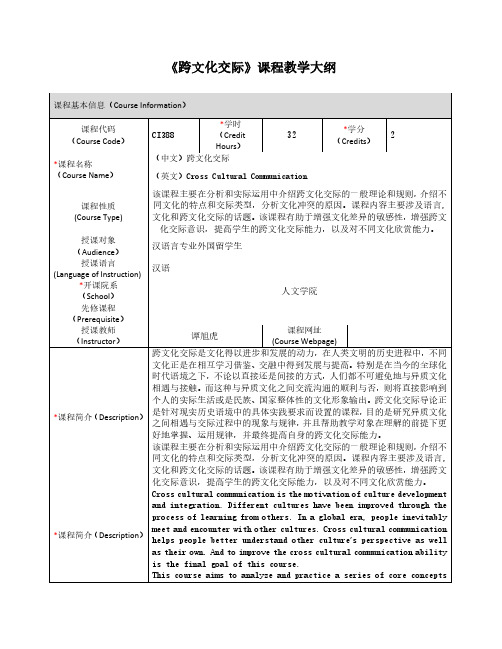
巨大影响力(A5.4)
3. 培养对异质文化的敏感度与欣赏能力(B3)
4.认识自身文化特征及其对跨文化交际的影响(B3)
5、提高自身的跨文化交际能力水平(B12)
6、通过跨文化交际复杂性的多视角学习培养出独立和批判性思维(B3,B12)
教学内容 学时 教学方式 作业及要求 基本要求 考查方式
第一章跨文 4
2
该课程主要在分析和实际运用中介绍跨文化交际的一般理论和规则,介绍不
课程性质
同文化的特点和交际类型,分析文化冲突的原因。课程内容主要涉及语言,
(Course Type)
文化和跨文化交际的话题。该课程有助于增强文化差异的敏感性,增强跨文
化交际意识,提高学生的跨文化交际能力,以及对不同文化欣赏能力。
授课对象 (Audience)
义”
切关系
第六章非言 2 语行为与跨 文化交际
第七章教育 4 与跨文化交 际
第八章 商 2 务、礼仪与跨 文化交际
第九章 文化 2 冲突与跨文 化适应
的词汇
讲授/讨论/
讲授/讨论/ 学生口头报
告
讲授/讨论/
讲授/讨论/
对自身文化 与中国文化 间“非言语 行为”的比 较,加深其 对跨文化交 际中“非言 语行为” 问 题的与认。
是针对现实历史语境中的具体实践要求而设置的课程,目的是研究异质文化 之间相遇与交际过程中的现象与规律,并且帮助教学对象在理解的前提下更
好地掌握、运用规律,并最终提高自身的跨文化交际能力。
该课程主要在分析和实际运用中介绍跨文化交际的一般理论和规则,介绍不
同文化的特点和交际类型,分析文化冲突的原因。课程内容主要涉及语言,
process of learning from others. In a global era, people inevitably
《跨文化交际》教学大纲
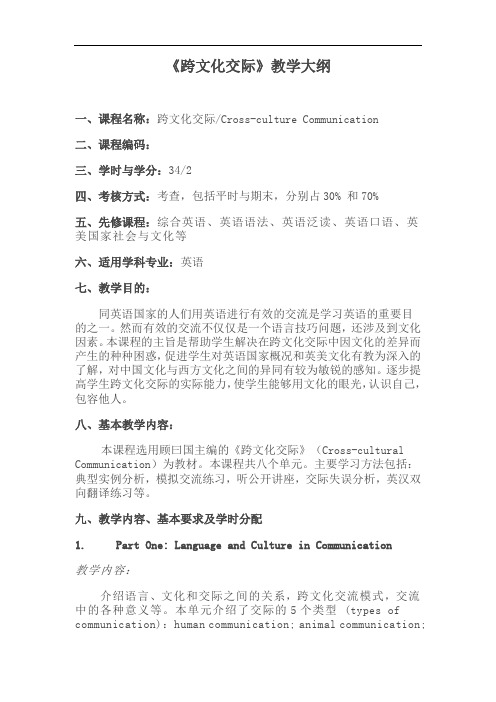
《跨文化交际》教学大纲一、课程名称:跨文化交际/Cross-culture Communication二、课程编码:三、学时与学分:34/2四、考核方式:考查,包括平时与期末,分别占30% 和70%五、先修课程:综合英语、英语语法、英语泛读、英语口语、英美国家社会与文化等六、适用学科专业:英语七、教学目的:同英语国家的人们用英语进行有效的交流是学习英语的重要目的之一。
然而有效的交流不仅仅是一个语言技巧问题,还涉及到文化因素。
本课程的主旨是帮助学生解决在跨文化交际中因文化的差异而产生的种种困惑,促进学生对英语国家概况和英美文化有教为深入的了解,对中国文化与西方文化之间的异同有较为敏锐的感知。
逐步提高学生跨文化交际的实际能力,使学生能够用文化的眼光,认识自己,包容他人。
八、基本教学内容:本课程选用顾曰国主编的《跨文化交际》(Cross-cultural Communication)为教材。
本课程共八个单元。
主要学习方法包括:典型实例分析,模拟交流练习,听公开讲座,交际失误分析,英汉双向翻译练习等。
九、教学内容、基本要求及学时分配1. Part One: Language and Culture in Communication教学内容:介绍语言、文化和交际之间的关系,跨文化交流模式,交流中的各种意义等。
本单元介绍了交际的5个类型 (types of communication):human communication; animal communication;human-animal communication; human-machine communication; machine-to-machine communication;交际的基本模式:同文化交际(mono-cultural language communication);跨文化交际(cross-cultural language communication);介绍各种交际方式中的“意思”的传达。
跨文化交际课程教学大纲(完整资料).doc

【最新整理,下载后即可编辑】跨文化交际课程教学大纲课程编码:03050262304 课程性质:专业必修课课时:36 学分:2开课学期:第6学期先修课程:英语国家概况,语言学,英美文学适用专业:商务英语专业课程简介:跨文化交际是商务英语专业高年级学生的一门必修课,本课程的教学目的,旨在培养商务英语专业学生在英语语言学习和应用过程中的跨文化意识,了解文化差异对交际活动的制约和影响,以有助于他们更好地在英语学习过程中发展跨文化交际能力,培养其对文化差异的敏感性,宽容性以及处理文化差异的灵活性,以适应日益广泛,深入的国际文化交流的需要。
一、课程教学目标该课程属于商务英语专业必修课之一,通过该课程的学习,帮助学生了解不同文化的特点和交际类型,分析文化冲突产生的原因,增强学生对文化差异的敏感性,解决学生在跨文化交际中因文化的差异而产生的种种困惑,提高学生对跨文化交际及其相关问题的分析能力,逐步提高学生跨文化交际的实际能力。
二、课程重点、难点该课程教学重点在于帮助学生认识中西文化的异同,分析文化差异的根源, 帮助学生深化对西方文化的理解,培养学生跨文化交际意识。
难点在于理解东西方在历史,思维方式以及哲学等方面的所体现的差异性。
三、整体课时分配章节序号章节名称理论学时实验学时1 绪论2 22 交际与文化 2 23 文化的影响 2 24 语言与文化 2 25 非言语交际 2 26 文化对商业语境的影响 2 27 文化对教育语境的影响 2 28 文化对保健语境的影响 2 29 培养跨文化交际意识 2 2四、课程内容安排(一)绪论主要内容:1.跨文化交际的概念、意义。
2.跨文化交际学的学科性质和发展历史。
教学要求:掌握跨文化交际的概念,了解跨文化交际的意义、历史、学科发展史。
(二)第一章交际与文化主要内容:1.交际的概念和特性。
2.文化的定义与特征。
3.文化与交际的关系。
教学要求:掌握文化与交际的概念,了解交际的特性、文化的特征,理解文化与交际之间的关系。
《英语跨文化交际》课程教学大纲
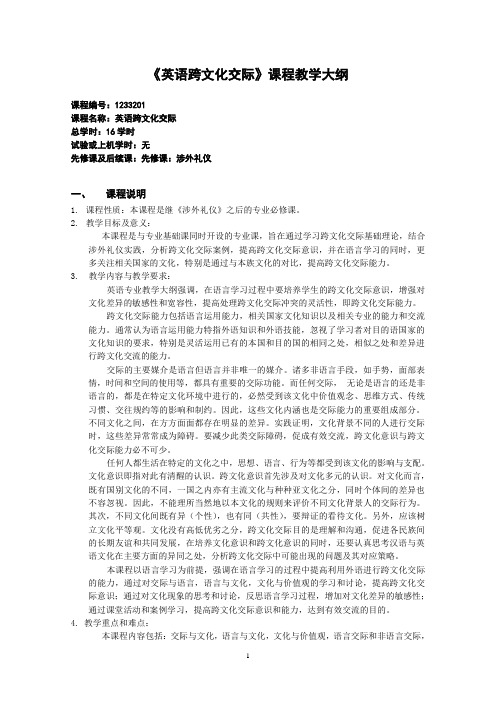
《英语跨文化交际》课程教学大纲课程编号:1233201课程名称:英语跨文化交际总学时:16学时试验或上机学时:无先修课及后续课:先修课:涉外礼仪一、课程说明1.课程性质:本课程是继《涉外礼仪》之后的专业必修课。
2.教学目标及意义:本课程是与专业基础课同时开设的专业课,旨在通过学习跨文化交际基础理论,结合涉外礼仪实践,分析跨文化交际案例,提高跨文化交际意识,并在语言学习的同时,更多关注相关国家的文化,特别是通过与本族文化的对比,提高跨文化交际能力。
3. 教学内容与教学要求:英语专业教学大纲强调,在语言学习过程中要培养学生的跨文化交际意识,增强对文化差异的敏感性和宽容性,提高处理跨文化交际冲突的灵活性,即跨文化交际能力。
跨文化交际能力包括语言运用能力,相关国家文化知识以及相关专业的能力和交流能力。
通常认为语言运用能力特指外语知识和外语技能,忽视了学习者对目的语国家的文化知识的要求,特别是灵活运用已有的本国和目的国的相同之处,相似之处和差异进行跨文化交流的能力。
交际的主要媒介是语言但语言并非唯一的媒介。
诸多非语言手段,如手势,面部表情,时间和空间的使用等,都具有重要的交际功能。
而任何交际,无论是语言的还是非语言的,都是在特定文化环境中进行的,必然受到该文化中价值观念、思维方式、传统习惯、交往规约等的影响和制约。
因此,这些文化内涵也是交际能力的重要组成部分。
不同文化之间,在方方面面都存在明显的差异。
实践证明,文化背景不同的人进行交际时,这些差异常常成为障碍。
要减少此类交际障碍,促成有效交流,跨文化意识与跨文化交际能力必不可少。
任何人都生活在特定的文化之中,思想、语言、行为等都受到该文化的影响与支配。
文化意识即指对此有清醒的认识。
跨文化意识首先涉及对文化多元的认识。
对文化而言,既有国别文化的不同,一国之内亦有主流文化与种种亚文化之分,同时个体间的差异也不容忽视。
因此,不能理所当然地以本文化的规则来评价不同文化背景人的交际行为。
《跨文化交际》教学大纲
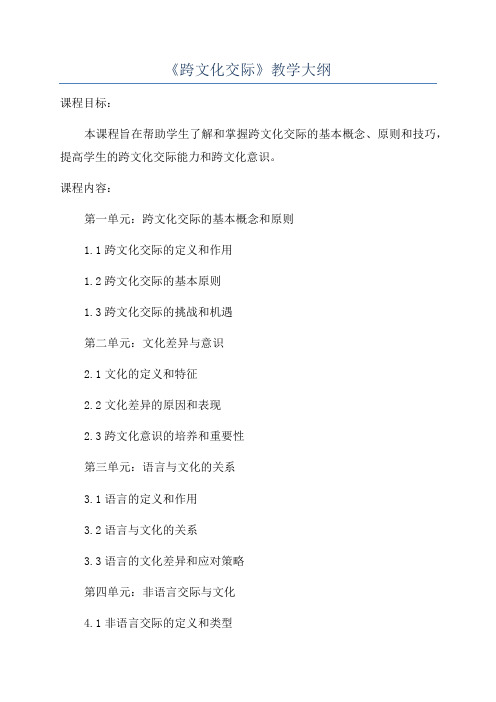
《跨文化交际》教学大纲课程目标:本课程旨在帮助学生了解和掌握跨文化交际的基本概念、原则和技巧,提高学生的跨文化交际能力和跨文化意识。
课程内容:第一单元:跨文化交际的基本概念和原则1.1跨文化交际的定义和作用1.2跨文化交际的基本原则1.3跨文化交际的挑战和机遇第二单元:文化差异与意识2.1文化的定义和特征2.2文化差异的原因和表现2.3跨文化意识的培养和重要性第三单元:语言与文化的关系3.1语言的定义和作用3.2语言与文化的关系3.3语言的文化差异和应对策略第四单元:非语言交际与文化4.1非语言交际的定义和类型4.2非语言交际的文化差异4.3非语言交际的意义和应用第五单元:跨文化沟通技巧5.1有效倾听与观察5.2调整自己的言语和行为5.3解决跨文化沟通中的问题和冲突教学方法:本课程将采用多元化的教学方法,包括讲授、案例分析、讨论、小组活动和角色扮演等。
评估方式:1.平时表现:包括课堂参与、小组活动表现等。
2.课堂作业:包括课后练习、案例分析报告等。
3.期末考试:对学生对课程内容的综合理解和应用能力进行考核。
参考教材:3. Bennett, M.J. (1993). Towards Ethnorelativism: A Developmental Model of Intercultural Sensitivity. In R. M. Paige (Ed.), Education for the Intercultural Experience (pp. 21-71). Yarmouth, ME: Intercultural Press.教学大纲制定者:XXX教授。
高中英语跨文化交际教案
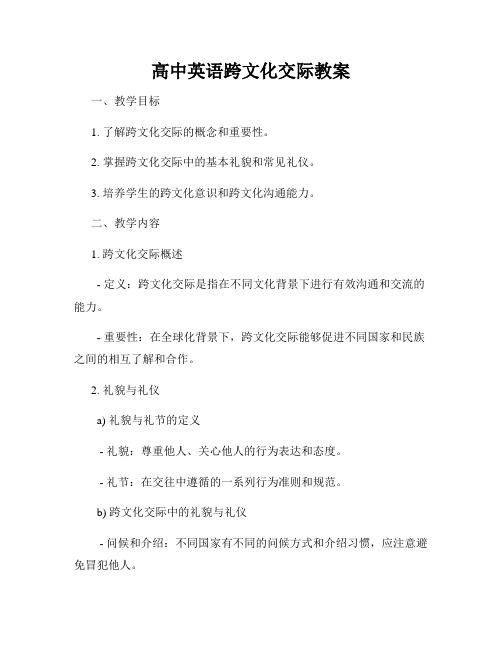
高中英语跨文化交际教案一、教学目标1. 了解跨文化交际的概念和重要性。
2. 掌握跨文化交际中的基本礼貌和常见礼仪。
3. 培养学生的跨文化意识和跨文化沟通能力。
二、教学内容1. 跨文化交际概述- 定义:跨文化交际是指在不同文化背景下进行有效沟通和交流的能力。
- 重要性:在全球化背景下,跨文化交际能够促进不同国家和民族之间的相互了解和合作。
2. 礼貌与礼仪a) 礼貌与礼节的定义- 礼貌:尊重他人、关心他人的行为表达和态度。
- 礼节:在交往中遵循的一系列行为准则和规范。
b) 跨文化交际中的礼貌与礼仪- 问候和介绍:不同国家有不同的问候方式和介绍习惯,应注意避免冒犯他人。
- 礼仪:对不同国家的饮食礼仪、礼品送礼方式等了解,避免造成文化冲突。
3. 跨文化意识与沟通策略a) 跨文化意识的培养- 尊重差异:不同国家、民族有不同的价值观念和行为习惯,应理解、尊重并接受这些差异。
- 文化敏感性:通过了解不同国家的历史、文化和社会背景,提高对跨文化交际的敏感性。
b) 跨文化沟通策略- 避免刻板印象:不应对某个国家的人民或文化有片面的、歧视性的评判。
- 学习有效沟通技巧:如适当运用肢体语言、避免使用难懂的俚语和口语,以确保信息传达的准确性。
三、教学过程1. 导入与引入- 通过举例子、图片或视频等方式,引出跨文化交际的概念和重要性。
2. 学习礼貌与礼仪- 分组讨论并总结不同国家的问候方式和介绍礼仪。
- 组织角色扮演活动,让学生在模拟情境中学习礼仪。
3. 培养跨文化意识- 提供跨文化案例,让学生讨论其中的文化差异与挑战。
4. 学习跨文化沟通策略- 分组学习并展示有效的跨文化沟通技巧和策略。
5. 拓展练习- 学生分角色进行跨文化交际对话,并通过讨论与点评互相提高。
四、教学评价1. 学生小组展示的内容和讨论的深度。
2. 角色扮演活动中学生的表现与沟通效果。
3. 跨文化交际对话的流畅度和准确性。
五、教学延伸1. 提供更多的跨文化案例和学习资源。
修订版《跨文化交际》教学大纲

修订版《跨文化交际》教学大纲引言:《跨文化交际》是一门有着重要意义的课程,旨在帮助学生更好地理解和应对不同文化背景下的交际挑战。
本教学大纲旨在修订原有的教学内容,以更好地满足学生需求和社会发展的要求。
一、课程目标:1.理解跨文化交际的概念和重要性。
2.学习不同文化背景下的交际方式和礼仪。
3.培养跨文化沟通能力和解决跨文化冲突的能力。
4.了解不同文化在商务、教育和社交等领域的影响。
5.提高自身的跨文化适应能力和文化敏感性。
二、教学内容:1.跨文化交际的概念和重要性a.介绍跨文化交际的定义和范围。
b.分析跨文化交际的重要性和意义。
c.探讨全球化背景下跨文化交际的挑战。
2.文化差异的认知a.介绍文化差异的概念和分类。
b.分析不同文化中的价值观、信念和行为模式。
c.比较不同文化的沟通风格和非语言交际。
3.跨文化交际中的交际策略a.介绍跨文化交际中的常见问题和挑战。
b.探讨有效的交际策略和技巧。
c.培养学生的非言语交际和倾听技巧。
4.跨文化冲突与解决a.分析跨文化冲突的原因和影响。
b.介绍跨文化冲突的解决方法和技巧。
c.案例分析和角色扮演,让学生实践解决冲突的能力。
5.文化影响与应用a.介绍不同文化在商务、教育和社交等领域的影响。
b.分析全球化背景下的文化融合和文化独特性。
c.讨论如何在不同文化场景中合理应用文化差异。
6.跨文化适应和文化敏感性培养a.介绍跨文化适应的重要性和方法。
b.探讨培养文化敏感性的途径和技巧。
c.组织跨文化体验活动,提高学生的跨文化适应能力。
三、教学方法:1.多媒体教学:使用图片、视频和教学软件引入跨文化交际的概念和案例。
2.讨论和演练:组织小组讨论和角色扮演,让学生实践跨文化交际的技巧和策略。
3.案例分析:通过案例分析,让学生理解跨文化交际中的挑战和解决方法。
4.互动教学:鼓励学生互相分享自己跨文化交际的经验和故事。
5.实践活动:组织跨文化体验活动,让学生亲身感受不同文化背景下的交际挑战。
跨文化交际教学大纲

跨文化交际》教学大纲、课程概述同英语国家的人们用英语进行有效的交流是学习英语的重要目的之一。
然而有效的交流不仅仅是一个语言技巧问题,还涉及到许多文化因素。
本课程的主旨是帮助学员解决在跨文化交际中因文化的差异而产生的种种问题。
本课程共8个单元。
第1单元介绍一些有关语言、文化和交际三者之间关系的一些基本概念。
其余7个单元主要为学员提供在处理跨文化交际中一些微妙问题时所需的基本知识和技巧,使他们意识到在同外国人(来自不同文化背景的人)交往中会因文化差异引起种种误解,以提高跨文化交流的质量。
二、学习目标通过8 个单元的学习,学员应能够认识语言、文化和交际三者之间的关系;对各类交际形式有所认识;对对象国文化有更进一步的了解, 更有效地进行交流;预料和避免由于不同的文化期望而产生的误解;解释手势和其他形式的体态语;讨论有关文化适应和相容的问题。
三、建议学习方法主要学习方法包括:典型实例分析、模拟交流练习、听公开讲座(磁带)、交际失误分析、英汉双向练习等。
四、考核本课程的考核由形成性考核及课程终结性考试两部分组成。
形成性考核占课程总成绩的20%,课程终结性考试占课程总成绩的80%。
形成性考核内容和方式严格按照《形成性考核及学习档案》的要求执行,课程终结性考试包括笔试和口试两个部分。
(具体见考核说明)五、各章简述第一单元语言、文化与交际内容:介绍语言、文化和交际之间的关系,跨文化交流模式,交流中的各种意义教学目的:帮助学员认识到语言和文化是不可分的,对语言的充分理解需要文化意识。
学习目标: 通过各种练习了解决定交际质量的基本要素,认识交际双方在交际过程中的交互作用,把握交际场合的定义、程式和价值观等。
UNIT 1 Language and Culture in CommunicationObjectives: by the end of the unit you will be able to:1.distinguish types of communication2.understand the basics of communication3.design a model for cross-cultural communication4.understand a variety of meanings in communication5.be aware of mutual monitoring process in a social situation6.be aware of different definitions of a social situation7.be aware of situational schema8.be aware of different values in communication9.be aware of non-verbal signals in communication10.reflect on conditions of effective speaker and listener in communication第二单元文化冲击内容:介绍不同文化背景的人接触时常常感到的种种“文化诧异”现象教学目的:通过对各种“文化诧异”现象的分析培养学员的文化意识。
- 1、下载文档前请自行甄别文档内容的完整性,平台不提供额外的编辑、内容补充、找答案等附加服务。
- 2、"仅部分预览"的文档,不可在线预览部分如存在完整性等问题,可反馈申请退款(可完整预览的文档不适用该条件!)。
- 3、如文档侵犯您的权益,请联系客服反馈,我们会尽快为您处理(人工客服工作时间:9:00-18:30)。
跨文化交际一、课程基本信息1、课程中、英文名称:跨化交文际、Cross-cultural Communication2、课程类别:专业专选课程3、课程学时:18学时4、学分:2分二、课程的目的与任务:跨文化交际作为一门学科涉及到文化和交际的各个层面,包括语言交际、非语言交际、人们之间的相互交往,以及不同文化之间的观念和信仰等。
该课程的目的在于通过不同文化差异的比较研究,分析跨文化交际案例,提高学生对文化差异的敏感性,提高不同文化语境中语言交际的能力,从而更好地适应不同文化环境。
使学生了解其他文化的社会文化习俗和价值观念;在语言学习的同时,更多关注相关国家的文化,特别是通过与本族文化的对比,提高跨文化交际能力,以适应社会发展和国际交流的需要,增加跨文化交际意识,并最终形成跨文化交际能力。
三、课程的重点和基本要求:(一)课程的重点本课程教学的重点是增强学生对跨文化交际中文化差异的敏感性,帮助学员解决在跨文化交际中因文化的差异而产生的种种问题。
通过典型实力分析,模拟交流联系,交际失误分析,英汉双向练习等多种形式,使学生认识语言,文化和交际三者之间的关系,加深对对象国文化的了解,掌握在处理跨文化交际中一些微妙问题时所需要的基本知识和技巧,提高跨文化交流的质量。
(二).基本要求:1、了解跨文化交际研究的范围和目前发展的动向。
2、掌握跨文化交际研究的基本方法,并运用来解决一些实际问题。
3、奠定向该学科研究纵深发展的理论基础。
四、教学内容及要求本课程以语言学习为前提,强调在语言学习的过程中提高利用外语进行跨文化交际的能力,通过对交际与语言,语言与文化,文化与价值观的学习和讨论,提高跨文化交际意识;通过对文化现象的思考和讨论,反思语言学习过程,增加对文化差异的敏感性;通过课堂活动和案例学习,提高跨文化交际意识和能力,达到有效交流的目的。
1.通过学习,学生能够了解语言及非语言交际在跨文化交际中的重要作用及应用规则。
2.学生应主要注重日常交际的模式化习得;理解中西方谈话风格、行为习惯、思维方式的不同以及克服障碍所需的沟通和理解。
同时,着重掌握中西方世界观在自然、知识、社会、时间及交际等认识方面上的差异性和互补性,增进中西方文化的交流与融合,培养自身的跨文化人格。
3.此外还要求学生通过听讲、阅读、讨论、观看视频、案例分析等方式提高跨文化交际能力。
在学习方式上,利用网络为本课程学生提供了大量的网上资料,包括本课程的教案、大纲、习题,以及展现中英文化特色的文化图片、文化视听材料等。
本课程的教学特点是寓教于乐,通过精心设计的课堂活动使学生仿佛身临其境般地感受他国文化,体验真实的跨文化交际感受。
通过案例分析和课堂讨论等方法使学生在轻松愉快的氛围中了解中英文化差异,学习跨文化交际的技巧,最终达到教学的目的。
具体内容安排及目的:1、An IntroductionIntroduction to the CourseWarm-up Cases2、CommunicationCultureIntercultural CommunicationTo grasp the requirements and assessment of this course; to get a general understanding of Intercultural Communication.3、Daily Verbal Communication(I)Warm-up CasesForm of AddressGreeting4、Daily Verbal Communication(II)Initiating Conversation and Conversation TopicVisitingPartingTo learn the daily expression in intercultural communication; to understand the form of address and conversation topic.5、Daily Verbal Communication (III)Compliments and Compliment ResponsesSocial Functions of ComplimentsDifferences between Chinese and English Compliments6、Daily Verbal Communication (IV)Common Response Formulas of English and Chinese ComplimentsCultural AssumptionExpression of Gratitude and Apology in English and ChineseTo learn the daily expression in intercultural communication; to understand the cultural assumption.7、Verbal Communication(I)Warm-up CasesCulturally Loaded WordsTo get the general understanding of the cultural connotation of words.8、Verbal Communication(II)Cultural Reflections on ProverbsTaboosTo get the general understanding of the cultural connotation of proverbs.9、Verbal Communication(III)Differences in Cultural Thought PatternsCultural PuzzlesTo get the general understanding of cultural thought pattern; to understand the relations between culture and language.10、Nonverbal Communication(I)Nonverbal Communication, Its Underestimated StatusNonverbal Communication, Its Study Areas11、Nonverbal Communication(II)Cultural Differences in Nonverbal CommunicationTime LanguageSpace LanguageTo grasp the importance of role of nonverbal communication in intercultural communication.12、Nonverbal Communication(III)Body LanguagePara-languageTo be familiar with the application rules.13、Cross-gender Communication(I)Warm-up CasesSex and GenderFeminine and Masculine Communication CulturesTo get a general understanding of cultural differences resulted from the differences of Gender consciousness.14、Cross-gender Communication(II)Understanding Cross-gender CommunicationSix Principles for Effective Cross-gender CommunicationTo overcome the obstacles in intercultural communication.15、Case Study and Performance16、Case Study and Performance17、Revision18、TEST五、教学方式与方法采用多媒体课件及板书辅助教学;学生讨论;学生PPT展示;视频观看等。
六、教材及参考书《跨文化交际实用教程》,胡超,外语教学与研究出版社,2012年。
《跨文化交际学》,贾玉新,上海外语教育出版社。
1997。
《中西文化之鉴》,Linell Davis,外语教学与研究出版社,2001年。
《跨文化交际面面观》,胡文仲,外语教学与研究出版社,1999年。
《跨文化交际案例分析》,廖华英,北京理工大学出版社,2010年。
七、考试方式闭卷考试、案例分析八、课程考核方案本课程为考试课,实行百分制,成绩构成如下:(一)平时成绩:包括考勤、课堂表现、作业、个人展示等;(二)考试成绩:100分(三)最终成绩组成说明:平时成绩30%+期末成绩70%九、辅导、答疑安排每周一次在办公室辅导、答疑。
Lesson 1 An IntroductionIntroduction to the CourseWarm-up CasesDiscussion1、Why take Intercultural Communication?Warm-up CasePlease discuss the case in groups and make a comment on it.A Case: Showing ConcernIn China:Xiao Li (an interpreter): You must be very tired. You’re old…Catherine (an elderly American lady): Oh, I’m NOT old, and I’m NOT tired. CommentWhat the interpreter said is quite courteous in China. It means, “If you are tired, we can take a little rest, since you are getting on in years.”The interpreter gave the impression that he thought the elderly lady would collapse any minute if she doesn’t rest immediately.In the West, there is a value placed in being young that many people consciously, or subconsciously, are not willing to accept that they are growing old. The western way of showing concern is generally different from the Chinese way. In China:Xiao Li (an interpreter): You must be very tired. You’re old…Catherine (an elderly American lady): Oh, I’m NOT old, and I’m NOT tired.The Chinese way of showing concern is usually expressed by statement.In the West:A: How are you doing now? Would you like to rest?B: No, not a bit.The western way of showing concern is mainly displayed with question.CommentThis case clearly shows that translation is an intercultural communication, which requires the translator/ interpreter to possess both English cultural knowledge and language competence.2、Different attitudes towards the same objectWhen one coin was lost…Englishman: Not surprised, shrugged his shoulders, going away, without being troubled by nothing.American man: Called a policeman, gave him his telephone number, left with a chewing gum in his mouth.German man: Made a mark within 100 miters on the ground, looking for the lost coin with a magnifying glass.Japanese man: felt sorry for his own carelessness, still blamed him at home, swearing not to make such a silly mistake again.3、People are culturally differentAgricultural Culture: worship land, love land, depend upon land, staying at point with movingNomadic Culture: worship nature, love nature, depend upon nature, moving from one place to another, not fixed at one point.Business Culture: ready to move farther and farther, making more profits for showing the value of life.If only 100 people left in the global village1. 17 speak Chinese2. 9 speak English3. 8 speak Dard4. 6 speak Spanish5. 6 speak Russian6. 4 speak Arabic.7. 50 speak Bengali Bangladesh,Japanese or French.4、People are religiously differentChristianity. About 21.4 billion Christians in the world. Bible. For philanthropy and equal for everybody.Islam. Meaning being obedient; Muslims are those who are obedient Quran. Buddhism. Are you a Buddhist? Buddhists are taught to live for kindness rather than evils.If only 100 people left in the global village1.33 Christians2.18 Moslems3.14 Hindus4.16 no religion5.6 Buddhists6.13 different religions5、People are ideologically differentChinese people and Asians are a bit modest, live for harmony, trying to avoid face to face conflict. Being collectivist.Westerners are being individualist, being equal and different. It is none of my business.6、People are racially differentIf only 100 people left in the global village1.61 Asians2.12 Europeans3.8 North Americans4.5 South Americans5.13 Africans6.1 AustralasianWhy take Intercultural Communication?People are different throughout the world, culturally, religiously, ideologically and racially, actually different in almost every aspect, therefore we are supposed to know about their differences as much as possible, just for a smooth communication among the Homo sapiens, the people in the global village. You will make it by coming to Intercultural Communication.The PurposeThe general purpose of this course is to understand the ways in which culture interrelates with and effects communication processes. Intercultural learning involves affective and behavioral processes, as well as cognitive ones. Throughout this course, you will have the opportunity to gain knowledge, skills and attitudes that will increase your intercultural communication competence.The Objectives1) To explore cultural self-awareness, other culture awareness and the dynamics that arise in interactions between the two.2) To understand how communication processes differ among cultures.3) To identify challenges that arise from these differences in intercultural interactions and learn ways to creatively address them.4) To acquire knowledge and develop skills that increase intercultural competence.5) To have an understanding of the meaning of the cultures understood by the westerners and the easterners or the Chinese and Americans.The Reasons1) Development of Science &Technology2) Globalization of Economy3)Widespread Immigration4) Development of Multiculturalism5) International Communication6) Interracial Communication7) Interethnic Communication or minority communication AssignmentsCase Study —— To Be Direct or NotLesson 2 CommunicationCultureIntercultural CommunicationWhat Is Culture?1.Define cultures yourselfPlease write down whatever comes to your mind when you hear or think of culture.Next, try to figure out how they are related to culture.2. Definition Final1) Culture is the total way of life that a group of people shares.2) Culture is a system of shared beliefs, values, customs, behaviors, and artifacts that the members of a society use to cope with their world and with one another, and that are transmitted from generation to generation through learning.3)Culture is an Integrated system of learned behavior patterns which are characteristic of the members of a society and which are not the result of biological inheritance.4) Culture is the deposit of knowledge, experience, beliefs, values, actions, attitudes, meanings, hierarchies, religion, notions of time, roles, spatial relations, concepts of the universe, and artifacts acquired by a group of people in the course of generations through individual and group striving.5)Culture is the total accumulation of beliefs, customs, values, behaviors, institutions and communication patterns that are shared, learned and passed down through the generations in an identifiable group of people.3. Elements of Culture4. Culture ——Three Ingredients:artifactsconcepts (beliefs, values, world views…)behaviore.g. Whereas the money is considered an artifact, then value placed on it is a concept, the actual spending and saving of the money is behavior.Culture Like an Iceberga. Objective culture:history, literature, and customs. ( visible, small part)b. Subjective culture: feelings and attitudes about things. (invisible, large part )The Cultural IcebergThe Iceberg of CultureObjective Culture & Subjective Culture1) fine arts, literature, drama, classical music, popular music, folk dancing, games, cooking, dress2) eye behavior, contextual conversation patterns, social interaction rite, facial expressions(1) notions of modesty, conception of beauty, ideal of child rearing, relationships to animals(2)patterns of superior/subordinate relations, definition of sin, courtship practices, conception of justice, incentives to work, notions of leadership, tempo of work, group decision-making(3)conception of cleanliness, attitudes towards dependents, theory of disease, approaches to problem-solving, conception of status mobility, status designations based on age, sex, class, occupation, kinship, etc.(4)nature of friendship, ordering of time, concept of “self”, preference for competition or cooperation, body language, notions about logic and validity, patterns of handling emotions6. Characteristics of Culture1) Culture is shared.The members of a culture share a set of ‘ideals, values, and standards of behaviors’, and this set of ideals is what gives meaning to their lives, and what bonds them together as a culture.2)Culture is learned.Actually, culture is not innate sensibility, but a learned characteristic. Children begin learning about their own culture at home with their immediate family and how they interact each other, how they dress, and the rituals they perform. When the children are growing in the community, their cultural education is advanced by watching social interactions, taking part in cultural activities and rituals in the community, forming their own relationships and taking their place in the culture.3) Culture is symbolic.In order for the culture to be transmitted from one person to the next, and from one generation to the next, a system of symbols needs to be created that translates the ideals of the culture to its members. This is accomplished through language, art, religion and money.4) Culture is integrated.For the sake of keeping the culture, functioning all aspects of the culture must be integrated. For example, the language must be able to describe all the functions within the culture in order for ideas and ideals to be transmitted from one person to another. Without the integration of language into the fabric of the culture, confusion and dysfunction would reign and the culture would fail.5) Culture is dynamic.It is necessary to recognize that cultures are dynamic rather than static. They are constantly changing and evolving under the impact of events and through contact with other cultures. Cultures change through three most common mechanisms: innovation, diffusion and acculturation (calamity).6) Culture is ethnocentric.Ethnocentrism is the belief that your own cultural background, including ways of analyzing problems, values, beliefs, language, and verbal and nonverbal communication, is correct. Ethnocentrists believe their culture is the central culture and other cultures are incorrect, ineffective, or quaint.CommunicationCan you give some examples to explain the word communication?What is communication?1.Definition of CommunicationGenerally speaking, communication can be defined as a dynamic, symbolic, transactional and contextual process in which people create shared meanings or messages.2.Eight Ingredients of Communicationbehavioral sourceEncodingmessagechannelresponderDecodingresponseFeedbackIntercultural Communication1.What is Intercultural Communication?Intercultural Communication means the exchange or communication between people who have different cultural backgrounds.2.Model of Intercultural CommunicationmentThe more similarities two cultures share, the less influence culture will have on communication. Therefore, the less messages will be changed during communication.The less the cultures are alike, the greater the influence of culture on communication will be, and the more likely the messages will be changed. Misunderstanding in intercultural communication often arises here.4. Barriers in Intercultural CommunicationLanguage differencesNonverbal communicationStereotypesCultural bias on judgmentsHigh level of stressThe Difference between Chinese and Western Cultures1. The attitudes by foreigners towards Chinese People2. The attitudes by Chinese towards Westerners3.Man and Nation4.The way of lifeAssignmentsVideo Watching:Gua Sha 《刮痧》Lesson 3 Daily Verbal Communication(I)Warm-up CasesForm of AddressGreetingObjectivesLearn the differences of addressing people and greeting between Chinese and western culture.Learn what are the topics at the beginning of the conversation.Learn how to visit someone and how to leave.Warm-up casesTwelve cups of teaQuestion 1:Why did I have 12 cups of tea?Question 2:How could you help “I” in this caseout of the awkward situation?1. Addressing PeopleDiscuss the differences in addressing people between English and Chinese cultures. How to address people?AcquaintanceMr. Ms. or Mrs. + surnameVIPTitle + full name/ surnameAmbassador大使Doctor博士Duke 公Marquis or Marquess侯Count or Earl伯Viscount子Baron男StrangerMr. Madam (only use the word Sir if he is much older than you or you don’t know his surname but he is a VIP)Young peopleYoung man Young LadyKid(s) Young Master(小王子)How to express fu +title?Tips:行政头衔以“副”字的表示副职的行政职务头衔,可用vice、deputy 表达。
